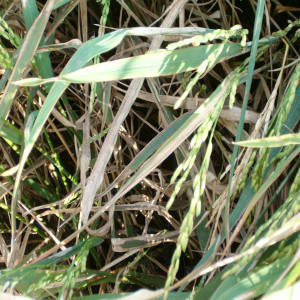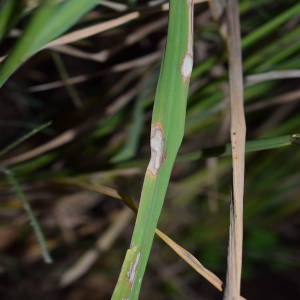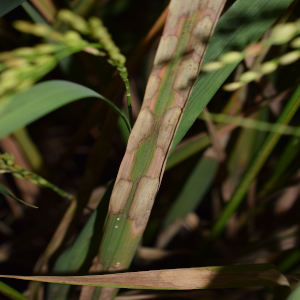- සි
- த

- Address : Bathalagoda, Ibbagamuwa, Sri Lanka
- E- Mail : rrdi@doa.gov.lk
- Telephone : +94 372 258561
- Fax : +94 372 259881
Rice In Sri Lanka - Rice Diseases
Sheath blight
Causative agent
Fungi, Thanatephorus cucumeris (Rhizoctonia solani)
Plant parts and life stages affected
Usually symptoms observed at the base of the stem close to water level. When disease spread, leaves and panicles could be infected.
Maximum tillering or flowering stage are more vulnerable..
Symptoms
Infection occurs through infected plants or sclerotia which survive in soil for a long time (depending on the temperature and moisture levels). In addition, infected straw, stubble, weeds could be the other sources of primary inoculums.
Spots or lesions initially develop near the water level (in flooded fields) or soil (in upland fields) and on the leaf sheath.
Spots or lesions might measure 1-3 cm long, may be oval or ellipsoidal initially but may get enlarged and irregular . Mainly on the leaf blade. Lesions are white in the center, banded with green, brown, and orange coloration.
At advanced stages, when the flag leaf is infected, panicle exertion is affected.
Asexual over-wintering structures known as sclerotia are formed on leaf sheath surface. They are usually 4-5 mm in diameter, white when young, turn brown or purplish brown at maturity and fall off easily on to soil surface and remain for years.





Conditions that favour the disease
High temperature (up to 400C)
High humidity (>90%)
Excessive use of nitrogen fertilizer
Foggy and dark climatic conditions
Shade
High densities of plants in the field, and varieties with higher number of tillers
Susceptible varieties
Almost all rice varieties are susceptible to the sheath blight in Sri Lanka
Disease Management
Within the crop season
Application of urea in recommended dosages or application of urea based on leaf colour chart.
If the disease spread fast, following fungicides could be applied
-
-
- Hexconazole 50G/L EC – dissolve 32 ml in 16 l of water (8-10 tanks per acre)
- Propiconazole 250 G/L EC – dissolve 16 ml in 16 l of water (8-10 tanks per acre)
- Thiophanate methyl 70% WP – dissolve 16 g in 16 l of water (8-10 tanks per acre)
- Pencicuron 25% WP – dissolve 32 g in 16 l of water (8-10 tanks per acre)
- Tebuconazole 250g/l EC – dissolve 10 ml in 16 l of water (8-10 tanks per acre)
-
If the crop is infected, following management options should be applied for the next season
-
-
- Use of certified seed paddy free from the disease
- Deep ploughing to bury infested plant residues into the soil
- Use of recommended seed rate i. e. 2 bushels per acre (direct sowing).
- Maintaining an average level plant population in the field
- Addition of burnt paddy husk (250 kg per acre) to the soil during land preparation.
- Abstain addition of disease infected straw
- There are no genetically resistant varieties to this disease. Varieties with clean plant base (less/no unproductive tillers) seem to escape the disease.
-
